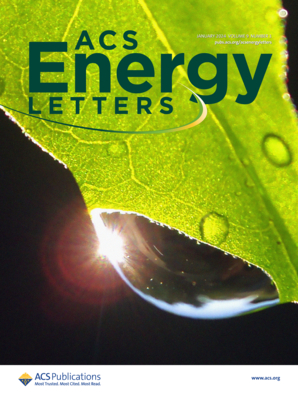Triphenylamine-Based Hole-Transporting Ligands for 2D/3D FAPbI3 Perovskite Solar Cells
IF 18.2
1区 材料科学
Q1 CHEMISTRY, PHYSICAL
引用次数: 0
Abstract
Two-dimensional (2D) perovskites suffer from poor charge transport due to the insulating nature of typically used organic spacers. Here, we develop a triphenylamine (TPA)-functionalized semiconducting ligand, namely, DPA-PEAI, in which the TPA moiety is tethered to the ethylammonium cation. Crystallographic analysis of n = 1 2D perovskite (DPA-PEA)2PbI4 reveals that the propeller-like geometry and enriched phenyl rings of the TPA tail enable the formation of multifarious π-stacking interconnections between neighboring ligands. Theoretical calculations further unveil that both the binding energy and hole transfer integral are augmented between the adjacent DPA-PEA cations, in contrast to the widely used phenylethylammonium (PEA) counterpart. This cross-electronic coupling feature allows the formation of multiple hole-transfer pathways within DPA-PEA-based 2D perovskites, enabling efficient out-of-plane charge transport, as confirmed by a set of characterizations. As a consequence, 2D/3D FAPbI3-based PSCs employing DPA-PEAI afford a champion efficiency of 25.7%, which ranks among the best efficiencies reported for conjugative ligands.

基于三苯胺的二维/三维FAPbI3钙钛矿太阳能电池的空穴运输配体
由于通常使用的有机间隔物的绝缘性质,二维(2D)钙钛矿的电荷输运较差。在这里,我们开发了一种三苯胺(TPA)功能化的半导体配体,即DPA-PEAI,其中TPA部分与乙基铵阳离子相连。对n = 1 2D钙钛矿(DPA-PEA)2PbI4的晶体学分析表明,TPA尾部的螺旋桨状几何结构和丰富的苯环使得相邻配体之间形成多种π-堆叠互连。理论计算进一步揭示,与广泛使用的苯乙基铵(PEA)相比,相邻的DPA-PEA阳离子之间的结合能和空穴转移积分都增加了。这种交叉电子耦合特性允许在基于dpa - pea的2D钙钛矿中形成多个空穴转移途径,从而实现高效的面外电荷传输,正如一系列表征所证实的那样。因此,采用DPA-PEAI的基于fapbi3的2D/3D PSCs的冠军效率为25.7%,是共轭配体中效率最高的之一。
本文章由计算机程序翻译,如有差异,请以英文原文为准。
求助全文
约1分钟内获得全文
求助全文
来源期刊

ACS Energy Letters
Energy-Renewable Energy, Sustainability and the Environment
CiteScore
31.20
自引率
5.00%
发文量
469
审稿时长
1 months
期刊介绍:
ACS Energy Letters is a monthly journal that publishes papers reporting new scientific advances in energy research. The journal focuses on topics that are of interest to scientists working in the fundamental and applied sciences. Rapid publication is a central criterion for acceptance, and the journal is known for its quick publication times, with an average of 4-6 weeks from submission to web publication in As Soon As Publishable format.
ACS Energy Letters is ranked as the number one journal in the Web of Science Electrochemistry category. It also ranks within the top 10 journals for Physical Chemistry, Energy & Fuels, and Nanoscience & Nanotechnology.
The journal offers several types of articles, including Letters, Energy Express, Perspectives, Reviews, Editorials, Viewpoints and Energy Focus. Additionally, authors have the option to submit videos that summarize or support the information presented in a Perspective or Review article, which can be highlighted on the journal's website. ACS Energy Letters is abstracted and indexed in Chemical Abstracts Service/SciFinder, EBSCO-summon, PubMed, Web of Science, Scopus and Portico.
 求助内容:
求助内容: 应助结果提醒方式:
应助结果提醒方式:


